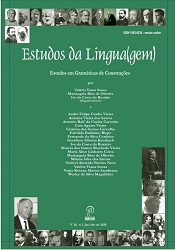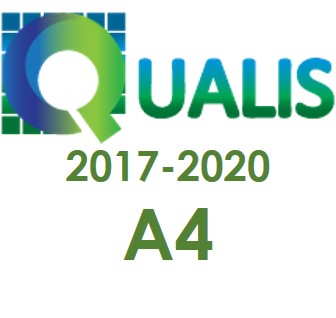O curioso caso das construções pseudoclivadas invertidas com pronome relativo ‘quen’ no galego: uma análise histórico-ontológica (The curious case of inverted pseudo-cleft constructions with relative pronoun ‘quen’ in galician: a historic-ontological analysis)
DOI:
https://doi.org/10.22481/el.v18i1.6127Palavras-chave:
Construção pseudoclivada invertida, galego, Gramática de construções baseada no uso, sintaxe, semânticaResumo
O presente artigo apresenta resultados parciais de uma pesquisa de doutoramento que tratou do desenvolvimento diacrônico de algumas construções de foco no galego entre os séculos XIII e XX. Este artigo se debruçará sobre os dados e análise de apenas uma dentre as construções de foco analisadas: Pseudoclivada Invertida com pronome relativo ‘QUEN’, atestada nos séculos XIX e XX. Orientando-me pela Gramática de Construções Baseada no Uso, defendo um quadro alternativo para classificação dos referentes focalizados por essa construção. O objetivo do artigo é apresentar uma proposta de explicação para o uso de um pronome relativo que, contrariando a expectativa gramatical, retoma um referente não humano.
Downloads
Referências
BYBEE, J. Language, Usage and Cognition. Cambridge: Cambridge University Press, 2010.
CUNHA VIEIRA, A. F. As construções de foco no galego é o que eu estou tentando entender. LaborHistórico, Rio de Janeiro, 3 (2): 71-96, jul. | dez. 2017, p. 71 – 96.
_____. Construções Clivadas no Galego é o que vais ter. 2018, 214 fl. Tese (Doutorado em Linguística) - Programa de Pós-graduação em Linguística, Universidade Federal do Rio de Janeiro, Rio de Janeiro, 2018.
CHAFE, Wallace L. Discourse, Consciousness and Time. Chicago: Univ. of Chicago Press, 1994.
CROFT, William. The role of domains in the interpretation of metaphors and metonymies. In: RENÉ, D. & PÖRINGS, R. Metaphor and metonymy in comparison and contrast. Berlin; New York: Mouton de Gruyter, 2003, p. 161 – 205.
GOLDBERG, Adele E. Constructions: A Construction Grammar Approach to Argument Structure. Chicago: University of Chicago Press, 1995.
HALLIDAY, Michael A. K. “Notes on transitivity and theme in English, Part 2”. In: Journal of Linguistics 3, 1967, p. 199-244.
HALLIDAY, Michael. A. K. & MATTHIESSEN, Christian. An Introduction to Functional Grammar. London; New York: Arnold, Oxford University Press Inc, 2004.
LAGARES, X. C.. Uma aproximação à língua das cantigas. Revista galega de filoloxía, v. 7, p. 95-116, 2006.
_____. Sobre a noção de galego-português. Cadernos de Letras da UFF, v. 35, p. 61-82, 2008.
_____. Galego-Português-Brasileiro: os desafios de uma perspectiva histórica integrada. In: Lagares, Xoán Carlos; Monteagudo, Henrique. (Org.). Galego e Português Brasileiro: história, variação e mudança. Niterói - Santiago: Editora da UFF - Universidade de Santiago de Compostela, 2012, v. 1, p. 11-36. A
_____. O galego e a lusofonía: a "nosa língua" e "os da banda d'alá".. In: Henrique Monteagudo. (Org.). Linguas, sociedades e política. Un debate multidisciplinar. 1ed.Santiago de Compostela: Consello da Cultura Galega, 2012, v. 1, p. 561-579. B
_____. O galego e os limites imprecisos do espaço lusófono.. In: Luiz Paulo da Moita Lopes. (Org.). O português no século XXI. Cenário geopolítico e sociolinguístico.. 1ed.São Paulo: Parábola, 2013, v. 1, p. 339-360.
LAGARES, X. C.; MONTEAGUDO, Henrique (Org.) . Galego e Português Brasileiro: história, variação e mudança. 1. ed. Niterói - Santiago: Editora da UFF - Universidade de Santiago de Compostela, 2012. v. 1. P. 221.
LEITE DE OLIVEIRA, D. Construções de foco com o marcador éto em russo. 2017, 269 fl. Tese (Doutorado em Linguística) – Programa de Pós-graduação em Linguística, Universidade Federal do Rio de Janeiro, Rio de Janeiro, 2017.
MARCUSCHI, Luiz Antônio. "Gêneros textuais: definição e funcionalidade". In: BEZERRA, Maria Auxiliadora; DIONÍZIO, Ângela Paiva; MACHADO, Ana Raquel (org.). Gêneros Textuais e Ensino. Rio de Janeiro: Editora Lucena, 2002.
MARIÑO, Ramón. Historia da lingua galega. Sotelo Blanco: Santiago de Compostela, 1998.
MONTEAGUDO, Henrique. Historia social da lingua galega. Galaxia: Vigo, 1999.
TRAUGOTT, E. C.; TROUSDALE, G.: Constructionalization and Constructional Changes. Oxford: Oxford University Press, 2013.
VITRAL, L. Gramática Inteligente do Português do Brasil. São Paulo: Contexto, 2017.
Downloads
Publicado
Como Citar
Edição
Seção
Licença
Copyright (c) 2020 Estudos da Língua(gem)

Este trabalho está licenciado sob uma licença Creative Commons Attribution 4.0 International License.
Autores que publicam em Estudos da Língua(gem) concordam com os seguintes termos:
Estudos da Língua(gem) mantém os direitos autorais das contribuições publicadas e disponibiliza seu conteúdo gratuitamente por meio do portal. Autores têm permissão e são estimulados a publicar e distribuir seu trabalho online em repositórios institucionais ou na sua página pessoal, com reconhecimento de autoria e créditos de publicação inicial nesta revista, indicando endereço online.






